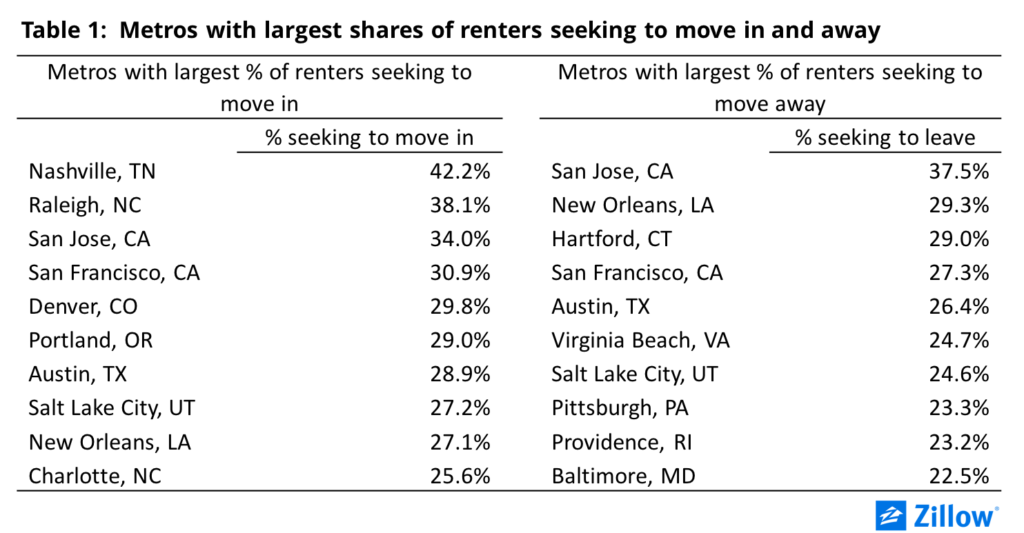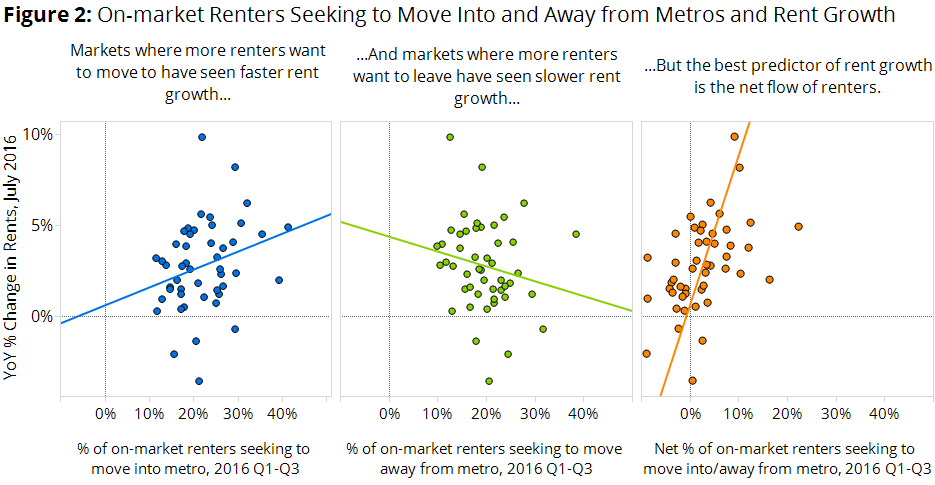What Distinguishes the Markets Renters Want to Move to From the Markets Renters Want to Leave
The (real or imagined) allure of greener pastures beyond the horizon is a near-constant theme in the American national imagination, and regional migration – the movement of people across the country – is among the most important drivers of local differences in housing demand and desirability. And in the simplest sense, areas with lots of people looking to leave can often be considered less desirable, while markets with lots of people eager to move in are likely more desirable. But not always.
- For renters on Zillow looking to make long distance moves, the California Bay Area is near the top of the list both for places where renters are looking to move to and looking to leave.
- The challenge for booming markets like Seattle, Portland and Denver is not necessarily that so many people want to move in, but also that so few people want to move away.
- Migrants – both those moving in and those moving away – tend to have higher incomes than renters moving within the region, although San Jose and San Francisco where housing affordability is approaching crisis levels are two critical exceptions.
The (real or imagined) allure of greener pastures beyond the horizon is a near-constant theme in the American national imagination, and regional migration – the movement of people across the country – is among the most important drivers of local differences in housing demand and desirability.
In the simplest sense, areas with lots of people looking to leave can often be considered less desirable, while markets with lots of people eager to move in are likely more desirable. But not always. Using a unique Zillow data set of on-market renters during the first three quarters of 2016 who completed Renter Profiles, Zillow ranked the relative appeal of different parts of the country for this sample of American renters.[1]
Markets in which many renters from outside the immediate area are searching for units typically feature some combination of affordability, strong labor markets and, often, broad cultural appeal. The relatively affordable metros of Nashville and Raleigh top the list of markets with the highest share of renters from other areas that want to move in. Those southern metros are joined on the list by booming, culturally dominant, but less-affordable markets including San Jose and San Francisco, and by the more-affordable tech towns of Denver, Austin, Portland and Salt Lake City. New Orleans, where the good times always seem to roll, also ranks in the top 10.
 But some of the same markets that have succeeded in capturing the attention of Americans from far away also appear on the list of markets that current residents want to escape, including San Francisco, San Jose and Austin. Other markets with large fractions of renters seeking to move away are characterized by weaker labor markets, poor housing affordability, or large populations of students and military families – places including Pittsburgh, Baltimore, and Virginia Beach.
But some of the same markets that have succeeded in capturing the attention of Americans from far away also appear on the list of markets that current residents want to escape, including San Francisco, San Jose and Austin. Other markets with large fractions of renters seeking to move away are characterized by weaker labor markets, poor housing affordability, or large populations of students and military families – places including Pittsburgh, Baltimore, and Virginia Beach.
In theory, markets attracting people from elsewhere in the country should experience rising rents, while markets that people want to leave should experience slower rent growth (or even rent declines). And while that’s largely true, the best predictor of rent growth is the difference between the share of renters seeking to move in and the share seeking to move out (figure 2).
 Hotel California
Hotel California
In booming cities like Seattle, Portland and Denver, there is sometimes the perception that large numbers of newcomers are driving rents upward. But while that is part of the story, it isn’t the full story. In these markets, the share of renters from far away looking to move in is high, though not the highest. More important to the rent growth narrative in these markets is that the share of renters currently living in the market and seeking to leave is very low.
High-churn markets like San Francisco, San Jose, New York and Washington, D.C., are accustomed to a steady population inflow and outflow. People come and go, and turnover itself can contribute to rising prices as each turnover is a new opportunity for landlords to reset the price of a unit to current market rates. The challenge for rental markets like Seattle, Portland and Denver is different. Would-be newcomers are chasing a pool of available units that might be bigger if only existing residents would move out. But since those existing residents are staying put, the supply of rental units is smaller and rents themselves have nowhere to go but up.
In other words, in these kind of “Hotel California” markets, people want to check in, but don’t appear to want to check out.
But even in high churn markets where people are coming and going, it’s important to look at who is coming and who is going. A chief concern in many communities is the extent to which newcomers are changing the social, cultural and economic profile of the places where they are moving.
Almost universally across the markets we examined, longer-distance movers – both those seeking to move in, and those seeking to move out – tend to have higher incomes than more local movers, those seeking to move a shorter distance within a metro. Economically, this makes sense: Moving is expensive. Except in the direst of cases, households that are willing to undertake long-distance moves have the financial and social capital to fund the journey. The income gap between newcomers and existing renters is largest in San Francisco, San Jose, Washington, DC, Baltimore, and New York. The income gap was smallest in Nashville, Providence, Atlanta, Salt Lake City and Orlando.
This economic trend is also true for renters seeking to move away from almost all of the markets we studied, with two critical exceptions: San Jose and San Francisco. In these two tech-heavy markets, where housing affordability has deteriorated to crisis levels, those seeking to move away report incomes less than or equal to those seeking to move within the region. Los Angeles, New York, Boston and Seattle are also approaching this important threshold, with renters seeking to leave the region reporting only slightly higher incomes than renters seeking to move within the region.
Lower-income renters (those reporting an income below the median for non-movers) in the Bay Area are overwhelmingly looking to move elsewhere in California. The top markets where they are looking move outside the Bay Area include Stockton, Sacramento, Vallejo, Los Angeles, Modesto, San Diego, Merced and Santa Rosa (Sonoma County). Seattle and Portland round out the top 10 destinations for lower-income renters seeking to move away from the Bay Area. This finding aligns with other data on regional migration – such as the American Community Survey (ACS) and Internal Revenue Service (IRS) County Migration data – suggesting that for the most part, households priced out of the Bay Area move elsewhere in California, especially the nearby markets of inland Northern California.
Our online searches reflect our dreams and curiosities as much as they reflect our actual intents. Researchers, analysts and policymakers should be particularly careful when attempting to extrapolate definitive conclusions regarding people’s behavior from inherently noisy online search data. But some data sources contain greater signal than others. Zillow’s unique insight into on-market renters is likely a more-reliable source – a hypothesis we intend to empirically test in the months and years ahead.
[1] This analysis includes data on the 50 largest metro markets in the United States.


